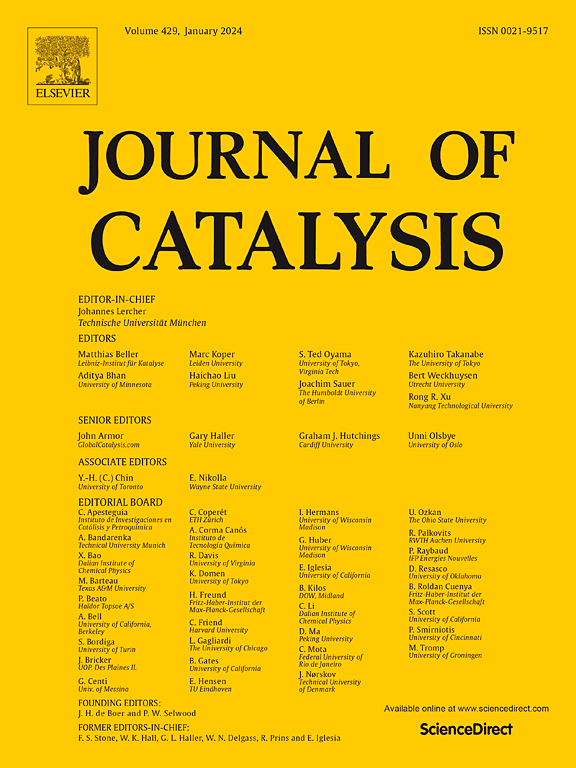Efficient one-pot synthesis of 2,5-furandicarboxylic acid from fructose and 5-hydroxymethylfurfural using synergistically active Ce-Al composite catalyst under mild conditions
IF 6.5
1区 化学
Q2 CHEMISTRY, PHYSICAL
引用次数: 0
Abstract
Using tert-butyl hydroperoxide (TBHP) as a low-cost oxidant, we synthesized, characterized, and evaluated heterogeneous bifunctional oxide catalysts composed of the non-noble metals Ce and Al in specific molar ratios, supported on glucose-derived carbon, for the conversion of 5-hydroxymethylfurfural (5-HMF) to 2,5-furandicarboxylic acid (2,5-FDCA) in dimethyl sulfoxide (DMSO). TBHP offers two advantages: it functions as an oxidant and generates tert-butanol, a valuable industrial solvent. We fully investigated catalyst loading, temperature, 5-HMF:TBHP molar ratio, reaction time, and reuse impact on product yield while correlating with the catalyst’s textural and chemical properties. CAOC-1, the best catalyst, achieved 98 % conversion, 82.0 % yield, and 83.54 % selectivity of 2,5-FDCA in optimal conditions (5-HMF (1 mmol), TBHP (9 mmol), DMSO (5 gm), CAOC-1 (50 mg), Temp (120 °C), 24 h), with minimal yield reduction over five reuse cycles. We used the bifunctional CAOC-1 in a one-pot, two-step system to directly transform fructose to 2,5-FDCA under mild conditions (fructose (1 mmol), TBHP (9 mmol), DMSO (5 gm), CAOC-1 (50 mg), temp (120 °C), 26 h) with minimal process modifications. The yield and selectivity of 2,5-FDCA were 80.26 % and 83.94 %, respectively. We proposed mechanistic pathways for dehydration and oxidation reactions, highlighting the catalyst’s bifunctional nature in facilitating high 2,5-FDCA yields from fructose and 5-HMF. The formation of the distinct redox environment of Ce and Al on carbon, the various oxidation states, and the oxygen vacancies in the CAOC-1 catalyst—all of which most likely operate as base-free oxidation active sites. One-pot reaction processes involve bifunctional CAOC-1 catalysts, –OH, and redox active sites (Ce), which play a significant role in dehydration and oxidation reactions, respectively. 2,5-FDCA is crucial to produce polyethylene 2,5-furandicarboxylate (PEF), a sustainable bioplastic and alternative to PET.


在温和条件下,采用协同活性Ce-Al复合催化剂,以果糖和5-羟甲基糠醛为原料,高效一锅合成2,5-呋喃二羧酸
采用叔丁基过氧化氢(thbhp)作为低成本氧化剂,合成了由非贵金属Ce和Al按特定摩尔比组成的非均相双功能氧化物催化剂,并对其进行了表征和评价,用于在二甲亚砜(DMSO)中将5-羟甲基糠醛(5-HMF)转化为2,5-呋喃二羧酸(2,5- fdca)。TBHP有两个优点:它可以作为氧化剂并产生一种有价值的工业溶剂——叔丁醇。我们充分研究了催化剂负载、温度、5-HMF: thbhp摩尔比、反应时间和重复使用对产物收率的影响,同时将催化剂的结构和化学性质联系起来。最佳催化剂CAOC-1在最佳条件下(5)-HMF(1 mmol)、TBHP(9 mmol)、DMSO (5 gm)、CAOC-1(50 mg)、温度(120 °C)、24 h)对2,5- fdca的转化率为98 %,收率为82.0 %,选择性为83.54 %,5次重复使用后收率降低最小。我们使用双功能的CAOC-1在一锅两步系统中直接将果糖转化为2,5- fdca,在温和的条件下(果糖(1 mmol), TBHP(9 mmol), DMSO (5 gm), CAOC-1(50 mg),温度(120 °C), 26 h)进行了最小的工艺修改。2,5- fdca的收率和选择性分别为80.26 %和83.94 %。我们提出了脱水和氧化反应的机制途径,强调了催化剂在促进果糖和5-羟甲基糠醛高2,5- fdca产量方面的双功能性质。Ce和Al在碳上形成不同的氧化还原环境,不同的氧化状态,以及cac -1催化剂中的氧空位,这些都很可能是无碱氧化活性位点。一锅反应过程涉及双功能CAOC-1催化剂-OH和氧化还原活性位点(Ce),它们分别在脱水和氧化反应中起重要作用。2,5- fdca是生产聚乙烯2,5-呋喃二羧酸酯(PEF)的关键,PEF是一种可持续的生物塑料和PET替代品。
本文章由计算机程序翻译,如有差异,请以英文原文为准。
求助全文
约1分钟内获得全文
求助全文
来源期刊

Journal of Catalysis
工程技术-工程:化工
CiteScore
12.30
自引率
5.50%
发文量
447
审稿时长
31 days
期刊介绍:
The Journal of Catalysis publishes scholarly articles on both heterogeneous and homogeneous catalysis, covering a wide range of chemical transformations. These include various types of catalysis, such as those mediated by photons, plasmons, and electrons. The focus of the studies is to understand the relationship between catalytic function and the underlying chemical properties of surfaces and metal complexes.
The articles in the journal offer innovative concepts and explore the synthesis and kinetics of inorganic solids and homogeneous complexes. Furthermore, they discuss spectroscopic techniques for characterizing catalysts, investigate the interaction of probes and reacting species with catalysts, and employ theoretical methods.
The research presented in the journal should have direct relevance to the field of catalytic processes, addressing either fundamental aspects or applications of catalysis.
 求助内容:
求助内容: 应助结果提醒方式:
应助结果提醒方式:


